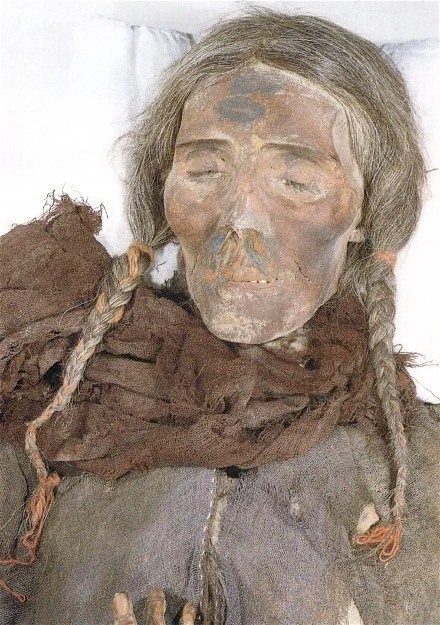The hidden depths of history have always astounded us, revealing unique cultures and civilizations that once flourished in distant lands. These remarkable discoveries allow us to peer into the past and uncover the lives of people who lived in ways that seem almost mythical to us today. One such extraordinary revelation comes from the desolate landscapes of the Tarim Basin, where archaeologists made a groundbreaking discovery—the remarkably well-preserved remains of a Tocharian woman. Her existence, frozen in time, offers an invaluable glimpse into the enigmatic world of the Tocharians, a lost Indo-European civilization that once thrived along the ancient trade routes of Central Asia.

The Tocharian Woman – A Mysterious Discovery
Buried beneath the sands of the Tarim Basin, in what is now the Xinjiang Uyghur Autonomous Region of northwest China, this ancient woman’s remains were astonishingly well-preserved, defying the relentless ravages of time. The arid conditions of the desert played a crucial role in her mummification, leaving her body, garments, and even some of her personal belongings intact. What makes this discovery so remarkable is not just the sheer age of the remains—estimated to be over 3,000 years old—but also the striking features of the Tocharian woman herself. Unlike the modern populations of the region, she bore distinctively Caucasian characteristics, with fair hair, high cheekbones, and deep-set eyes. These physical traits challenge conventional notions of the region’s historical inhabitants and raise intriguing questions about the movements and interactions of ancient peoples.
The Tocharians were an Indo-European people who are believed to have migrated eastward, establishing settlements along the Silk Road. They spoke Tocharian, a now-extinct branch of the Indo-European language family, and their presence in the Tarim Basin provides compelling evidence of the vast cultural exchanges that took place in antiquity. The discovery of the Tocharian woman, along with other well-preserved mummies found in the region, suggests that these people maintained sophisticated trade networks and had extensive contact with civilizations across both East and West.
A Glimpse into a Forgotten Civilization
The attire of the Tocharian woman is one of the most fascinating aspects of her discovery. Her clothing was intricately woven, featuring vibrant colors and patterns that reveal a high level of textile craftsmanship. The fabrics were made of wool, suggesting that the Tocharians practiced animal husbandry and possessed advanced weaving techniques. The presence of dyes in her garments, derived from plants, indicates knowledge of botanical resources and textile production methods that were surprisingly refined for the time.
Additionally, the burial artifacts found alongside her remains hint at the beliefs and customs of her people. Some items suggest a spiritual or ritualistic significance, potentially indicating that the Tocharians practiced a form of religious worship. These artifacts provide archaeologists with clues about their social structure, daily life, and even their connections to other ancient civilizations.
The Significance of the Tarim Mummies
The discovery of the Tocharian woman is part of a broader pattern of finds in the Tarim Basin, where numerous well-preserved mummies have been unearthed. These remains, dating back to different periods, suggest that the region was home to a diverse and dynamic population over thousands of years. Some mummies appear to have distinct European features, while others bear characteristics more commonly associated with Central and East Asian populations, underscoring the region’s role as a crossroads of cultural and genetic exchange.
Historical records and linguistic studies indicate that the Tocharians had a thriving society that engaged in agriculture, animal husbandry, and trade. Their language, preserved in ancient manuscripts, shows links to other Indo-European tongues, further proving that they were part of a vast and interconnected ancient world.
A Legacy Lost to Time
Despite their historical significance, the Tocharians eventually faded from history, likely due to changing trade routes, climate shifts, and incursions from other civilizations. Over time, their settlements disappeared, and their language was lost, leaving only archaeological remnants and historical texts to tell their story. The discovery of the Tocharian woman provides a rare and invaluable link to this lost world, offering a glimpse into a past that might have otherwise remained forgotten.
Modern scientific techniques, such as DNA analysis, continue to shed light on the origins and movements of the Tocharians. Genetic studies have confirmed their European ancestry, further supporting the theory that they migrated eastward from the Eurasian Steppe thousands of years ago. These findings challenge traditional narratives about early human migrations and highlight the complex nature of ancient cultural interactions.
Unraveling the Mysteries of the Past
The discovery of the Tocharian woman and the broader Tarim mummies presents a compelling reminder of how much remains unknown about our collective past. Each new excavation, each scientific breakthrough, adds another piece to the intricate puzzle of human history. The Tocharians, once thought to be a mere footnote in the annals of time, have now captured the imagination of archaeologists, historians, and the general public alike.
Their story is a testament to the resilience of human civilizations, the constant movement of peoples across vast landscapes, and the enduring connections between East and West. The Tocharian woman, with her enigmatic presence, offers us a fleeting but profound connection to a civilization that, though lost, still speaks to us across the millennia.
As researchers continue to explore the depths of the Tarim Basin, who knows what further revelations may await? The sands of time may conceal countless untold stories, waiting for the right moment to be unearthed, adding new chapters to the ever-expanding narrative of human history.





